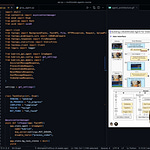Ready to see what I’ve been building? 👀
Many of you have told me you like how I structure my projects with good software practices.
But I know it’s not always easy to extract that structure, since most of my projects are pretty specific.
A cookiecutter designed to build Agent APIs in a structured and robust way f…
Listen to this episode with a 7-day free trial
Subscribe to The Neural Maze to listen to this post and get 7 days of free access to the full post archives.






